BM533 - Contemporary Business Economics: Brexit Impact on ALDI
VerifiedAdded on 2023/06/18
|9
|1914
|424
Report
AI Summary
This report examines the principles of demand and supply within the context of the UK's economic landscape, particularly in light of events like COVID-19 and Brexit. It analyzes how these factors influence business performance, focusing on ALDI as a case study. The report details the law of demand, exploring how factors like income, related goods, taste, and expectations affect consumer behavior. It also discusses the law of supply, considering how input prices, climate, technology, and the number of producers impact supply curves. The analysis further delves into the movement along demand and supply curves, considering scenarios such as shortages caused by the pandemic and the implications of Brexit on raw material costs and trade. Ultimately, the report emphasizes the importance of analyzing these factors to make informed business decisions.
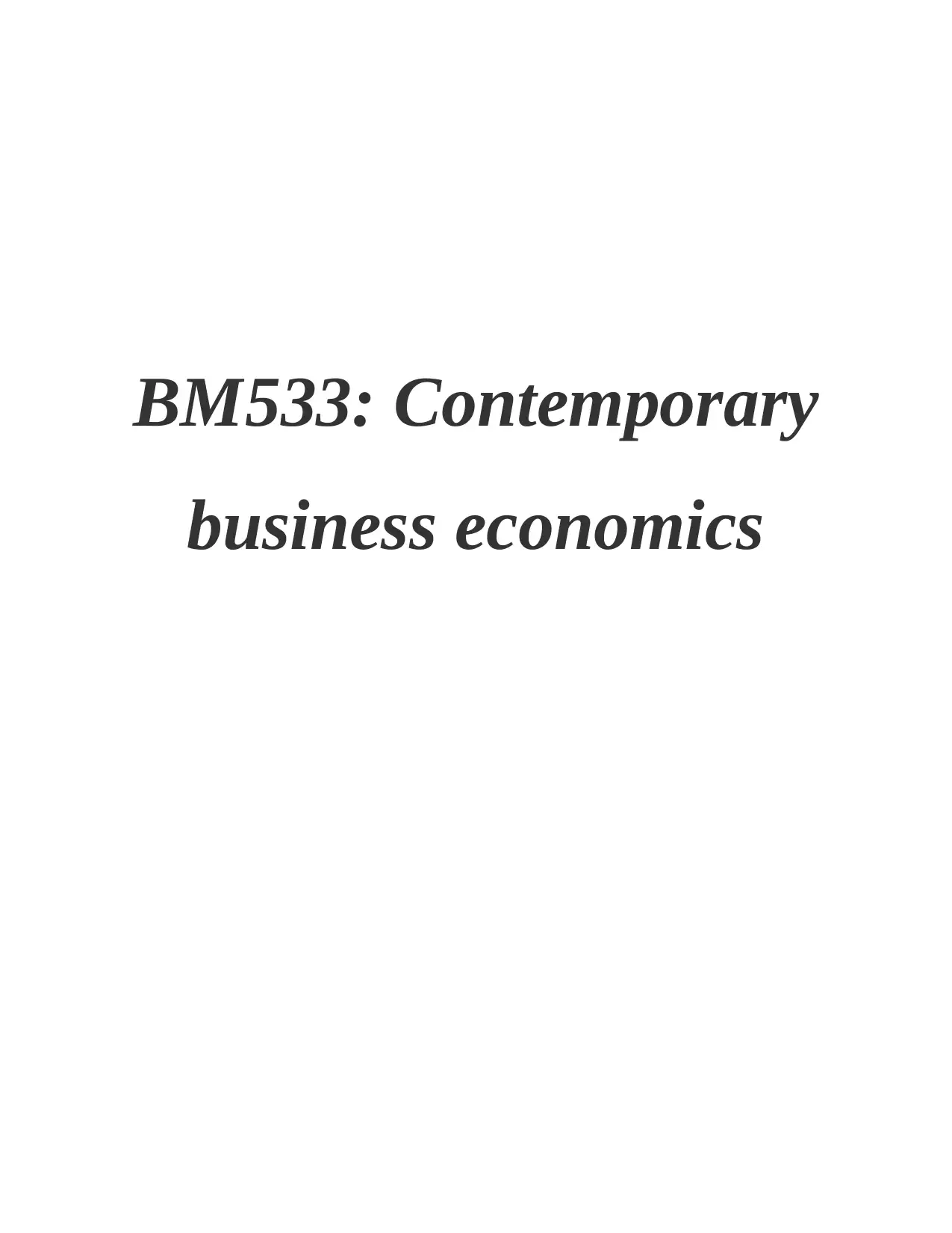
BM533: Contemporary
business economics
business economics
Paraphrase This Document
Need a fresh take? Get an instant paraphrase of this document with our AI Paraphraser
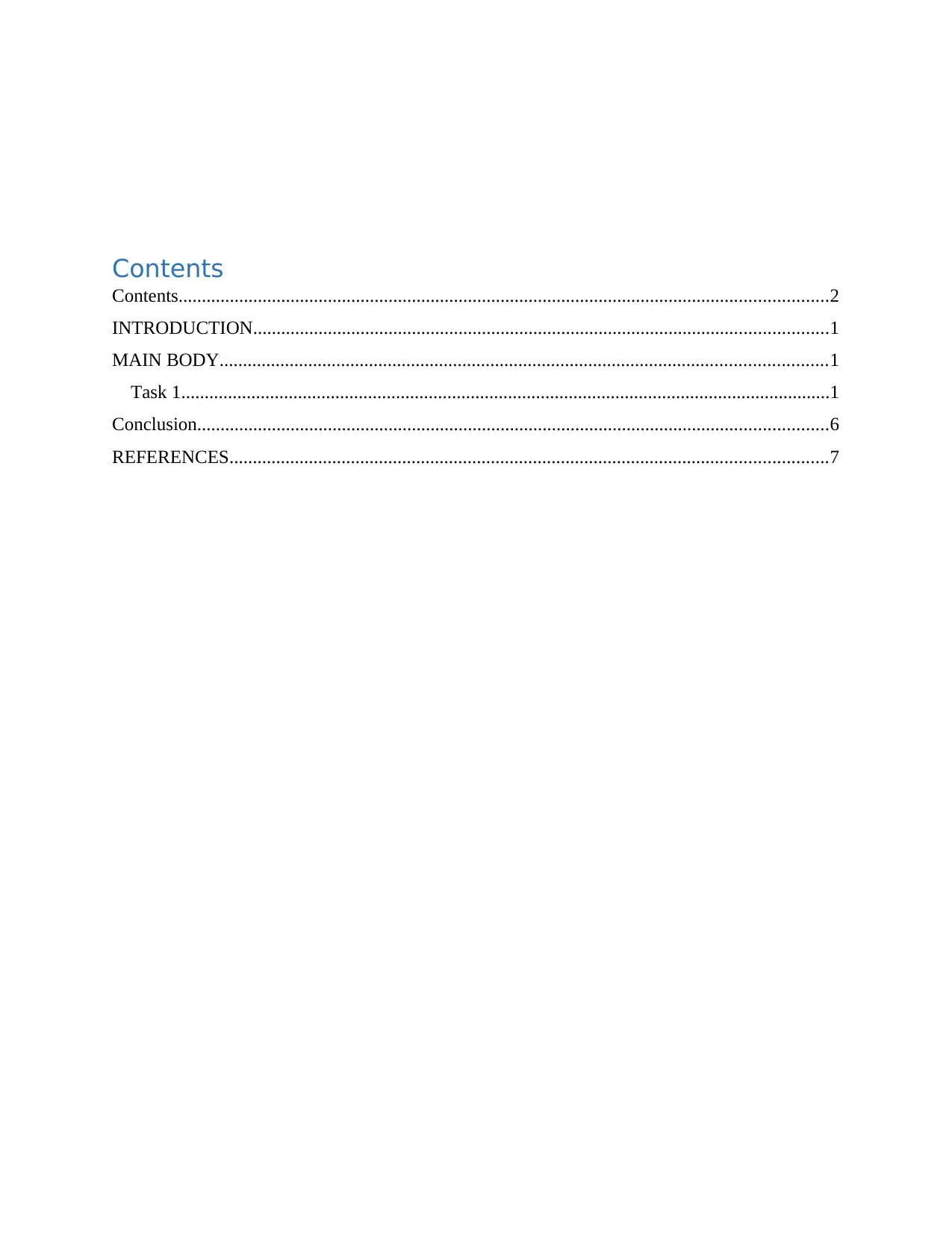
Contents
Contents...........................................................................................................................................2
INTRODUCTION...........................................................................................................................1
MAIN BODY..................................................................................................................................1
Task 1...........................................................................................................................................1
Conclusion.......................................................................................................................................6
REFERENCES................................................................................................................................7
Contents...........................................................................................................................................2
INTRODUCTION...........................................................................................................................1
MAIN BODY..................................................................................................................................1
Task 1...........................................................................................................................................1
Conclusion.......................................................................................................................................6
REFERENCES................................................................................................................................7
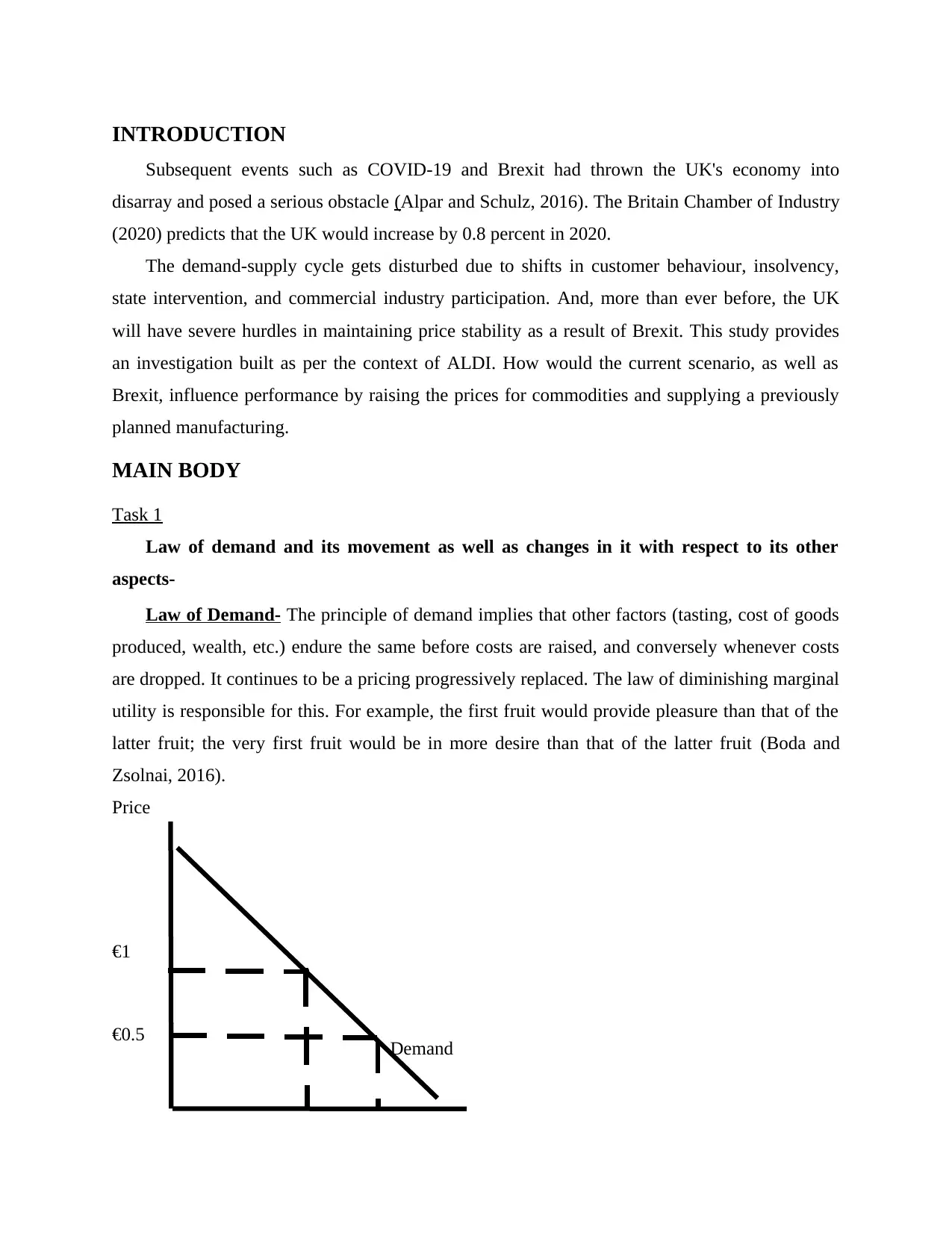
INTRODUCTION
Subsequent events such as COVID-19 and Brexit had thrown the UK's economy into
disarray and posed a serious obstacle (Alpar and Schulz, 2016). The Britain Chamber of Industry
(2020) predicts that the UK would increase by 0.8 percent in 2020.
The demand-supply cycle gets disturbed due to shifts in customer behaviour, insolvency,
state intervention, and commercial industry participation. And, more than ever before, the UK
will have severe hurdles in maintaining price stability as a result of Brexit. This study provides
an investigation built as per the context of ALDI. How would the current scenario, as well as
Brexit, influence performance by raising the prices for commodities and supplying a previously
planned manufacturing.
MAIN BODY
Task 1
Law of demand and its movement as well as changes in it with respect to its other
aspects-
Law of Demand- The principle of demand implies that other factors (tasting, cost of goods
produced, wealth, etc.) endure the same before costs are raised, and conversely whenever costs
are dropped. It continues to be a pricing progressively replaced. The law of diminishing marginal
utility is responsible for this. For example, the first fruit would provide pleasure than that of the
latter fruit; the very first fruit would be in more desire than that of the latter fruit (Boda and
Zsolnai, 2016).
Price
€1
€0.5 Demand
Subsequent events such as COVID-19 and Brexit had thrown the UK's economy into
disarray and posed a serious obstacle (Alpar and Schulz, 2016). The Britain Chamber of Industry
(2020) predicts that the UK would increase by 0.8 percent in 2020.
The demand-supply cycle gets disturbed due to shifts in customer behaviour, insolvency,
state intervention, and commercial industry participation. And, more than ever before, the UK
will have severe hurdles in maintaining price stability as a result of Brexit. This study provides
an investigation built as per the context of ALDI. How would the current scenario, as well as
Brexit, influence performance by raising the prices for commodities and supplying a previously
planned manufacturing.
MAIN BODY
Task 1
Law of demand and its movement as well as changes in it with respect to its other
aspects-
Law of Demand- The principle of demand implies that other factors (tasting, cost of goods
produced, wealth, etc.) endure the same before costs are raised, and conversely whenever costs
are dropped. It continues to be a pricing progressively replaced. The law of diminishing marginal
utility is responsible for this. For example, the first fruit would provide pleasure than that of the
latter fruit; the very first fruit would be in more desire than that of the latter fruit (Boda and
Zsolnai, 2016).
Price
€1
€0.5 Demand
You're viewing a preview
Unlock full access by subscribing today!
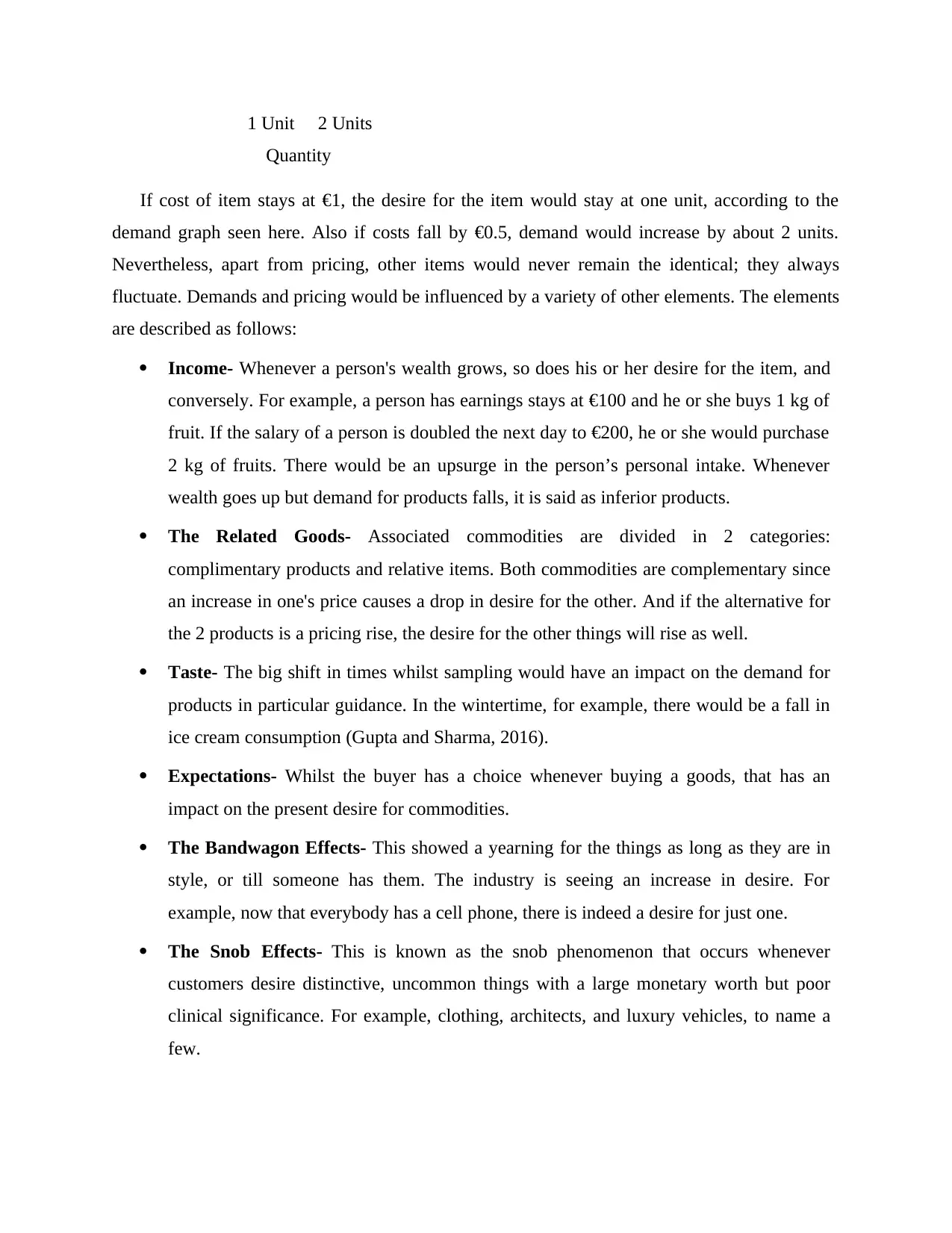
1 Unit 2 Units
Quantity
If cost of item stays at €1, the desire for the item would stay at one unit, according to the
demand graph seen here. Also if costs fall by €0.5, demand would increase by about 2 units.
Nevertheless, apart from pricing, other items would never remain the identical; they always
fluctuate. Demands and pricing would be influenced by a variety of other elements. The elements
are described as follows:
Income- Whenever a person's wealth grows, so does his or her desire for the item, and
conversely. For example, a person has earnings stays at €100 and he or she buys 1 kg of
fruit. If the salary of a person is doubled the next day to €200, he or she would purchase
2 kg of fruits. There would be an upsurge in the person’s personal intake. Whenever
wealth goes up but demand for products falls, it is said as inferior products.
The Related Goods- Associated commodities are divided in 2 categories:
complimentary products and relative items. Both commodities are complementary since
an increase in one's price causes a drop in desire for the other. And if the alternative for
the 2 products is a pricing rise, the desire for the other things will rise as well.
Taste- The big shift in times whilst sampling would have an impact on the demand for
products in particular guidance. In the wintertime, for example, there would be a fall in
ice cream consumption (Gupta and Sharma, 2016).
Expectations- Whilst the buyer has a choice whenever buying a goods, that has an
impact on the present desire for commodities.
The Bandwagon Effects- This showed a yearning for the things as long as they are in
style, or till someone has them. The industry is seeing an increase in desire. For
example, now that everybody has a cell phone, there is indeed a desire for just one.
The Snob Effects- This is known as the snob phenomenon that occurs whenever
customers desire distinctive, uncommon things with a large monetary worth but poor
clinical significance. For example, clothing, architects, and luxury vehicles, to name a
few.
Quantity
If cost of item stays at €1, the desire for the item would stay at one unit, according to the
demand graph seen here. Also if costs fall by €0.5, demand would increase by about 2 units.
Nevertheless, apart from pricing, other items would never remain the identical; they always
fluctuate. Demands and pricing would be influenced by a variety of other elements. The elements
are described as follows:
Income- Whenever a person's wealth grows, so does his or her desire for the item, and
conversely. For example, a person has earnings stays at €100 and he or she buys 1 kg of
fruit. If the salary of a person is doubled the next day to €200, he or she would purchase
2 kg of fruits. There would be an upsurge in the person’s personal intake. Whenever
wealth goes up but demand for products falls, it is said as inferior products.
The Related Goods- Associated commodities are divided in 2 categories:
complimentary products and relative items. Both commodities are complementary since
an increase in one's price causes a drop in desire for the other. And if the alternative for
the 2 products is a pricing rise, the desire for the other things will rise as well.
Taste- The big shift in times whilst sampling would have an impact on the demand for
products in particular guidance. In the wintertime, for example, there would be a fall in
ice cream consumption (Gupta and Sharma, 2016).
Expectations- Whilst the buyer has a choice whenever buying a goods, that has an
impact on the present desire for commodities.
The Bandwagon Effects- This showed a yearning for the things as long as they are in
style, or till someone has them. The industry is seeing an increase in desire. For
example, now that everybody has a cell phone, there is indeed a desire for just one.
The Snob Effects- This is known as the snob phenomenon that occurs whenever
customers desire distinctive, uncommon things with a large monetary worth but poor
clinical significance. For example, clothing, architects, and luxury vehicles, to name a
few.
Paraphrase This Document
Need a fresh take? Get an instant paraphrase of this document with our AI Paraphraser
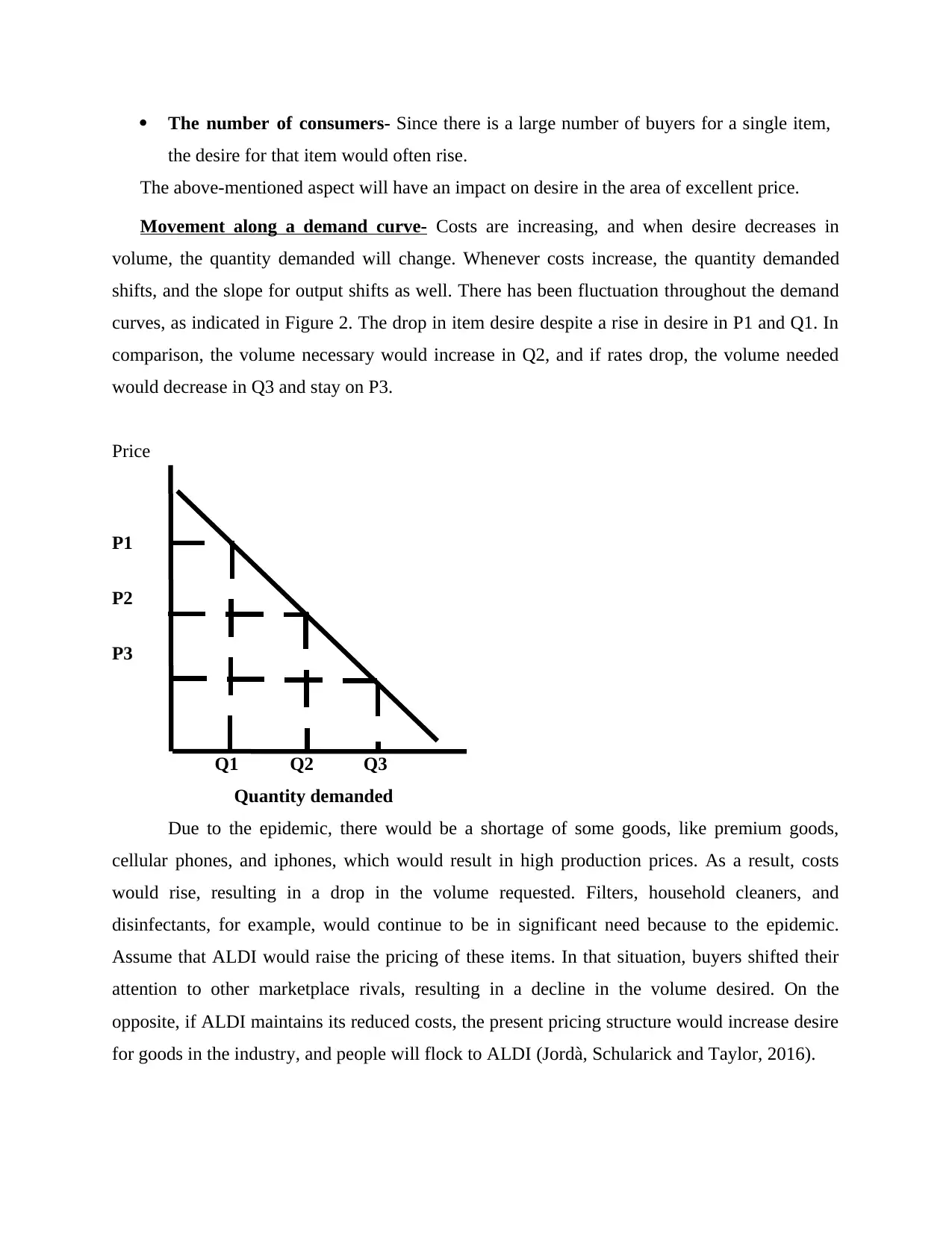
The number of consumers- Since there is a large number of buyers for a single item,
the desire for that item would often rise.
The above-mentioned aspect will have an impact on desire in the area of excellent price.
Movement along a demand curve- Costs are increasing, and when desire decreases in
volume, the quantity demanded will change. Whenever costs increase, the quantity demanded
shifts, and the slope for output shifts as well. There has been fluctuation throughout the demand
curves, as indicated in Figure 2. The drop in item desire despite a rise in desire in P1 and Q1. In
comparison, the volume necessary would increase in Q2, and if rates drop, the volume needed
would decrease in Q3 and stay on P3.
Price
P1
P2
P3
Q1 Q2 Q3
Quantity demanded
Due to the epidemic, there would be a shortage of some goods, like premium goods,
cellular phones, and iphones, which would result in high production prices. As a result, costs
would rise, resulting in a drop in the volume requested. Filters, household cleaners, and
disinfectants, for example, would continue to be in significant need because to the epidemic.
Assume that ALDI would raise the pricing of these items. In that situation, buyers shifted their
attention to other marketplace rivals, resulting in a decline in the volume desired. On the
opposite, if ALDI maintains its reduced costs, the present pricing structure would increase desire
for goods in the industry, and people will flock to ALDI (Jordà, Schularick and Taylor, 2016).
the desire for that item would often rise.
The above-mentioned aspect will have an impact on desire in the area of excellent price.
Movement along a demand curve- Costs are increasing, and when desire decreases in
volume, the quantity demanded will change. Whenever costs increase, the quantity demanded
shifts, and the slope for output shifts as well. There has been fluctuation throughout the demand
curves, as indicated in Figure 2. The drop in item desire despite a rise in desire in P1 and Q1. In
comparison, the volume necessary would increase in Q2, and if rates drop, the volume needed
would decrease in Q3 and stay on P3.
Price
P1
P2
P3
Q1 Q2 Q3
Quantity demanded
Due to the epidemic, there would be a shortage of some goods, like premium goods,
cellular phones, and iphones, which would result in high production prices. As a result, costs
would rise, resulting in a drop in the volume requested. Filters, household cleaners, and
disinfectants, for example, would continue to be in significant need because to the epidemic.
Assume that ALDI would raise the pricing of these items. In that situation, buyers shifted their
attention to other marketplace rivals, resulting in a decline in the volume desired. On the
opposite, if ALDI maintains its reduced costs, the present pricing structure would increase desire
for goods in the industry, and people will flock to ALDI (Jordà, Schularick and Taylor, 2016).
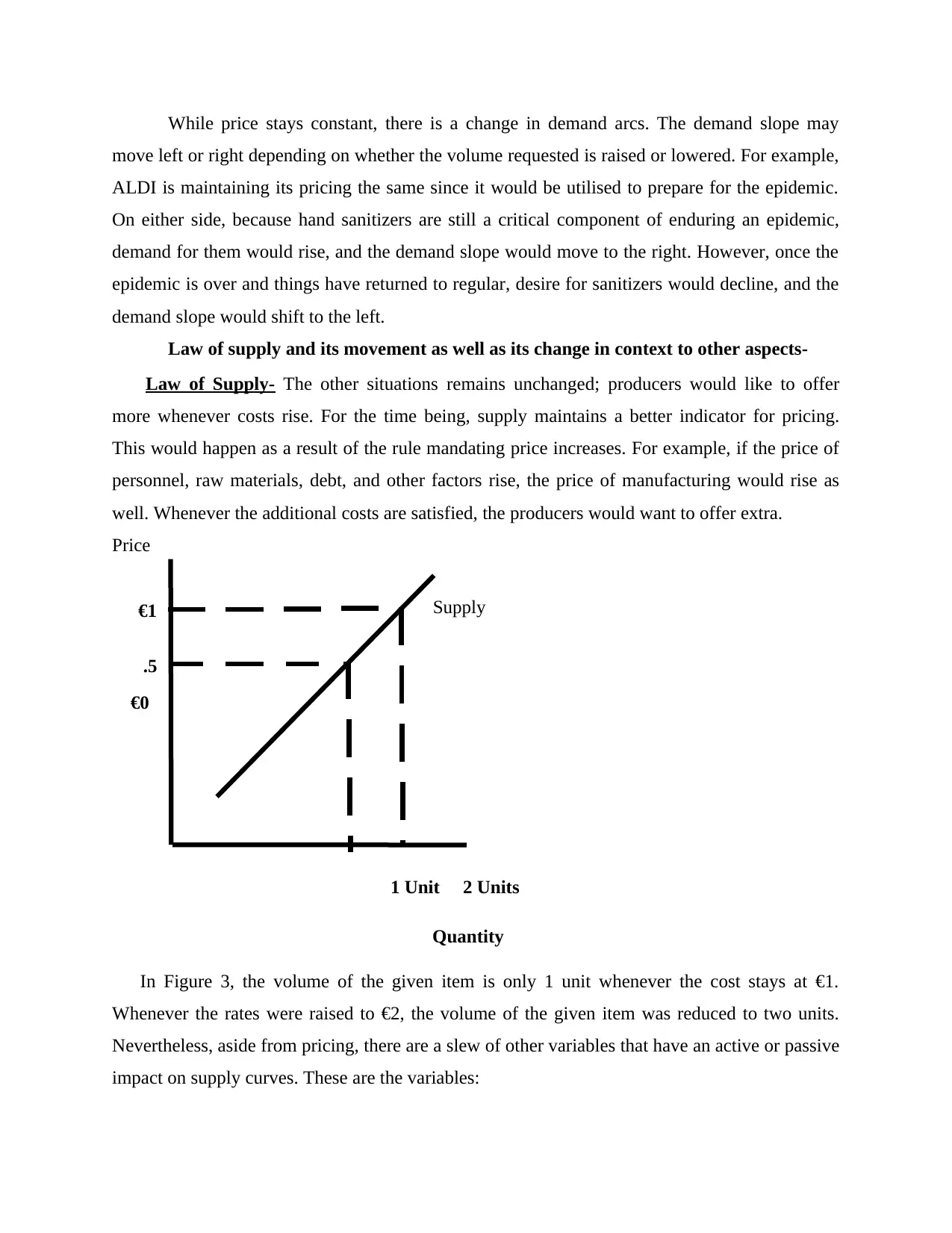
€1 Supply
.5
While price stays constant, there is a change in demand arcs. The demand slope may
move left or right depending on whether the volume requested is raised or lowered. For example,
ALDI is maintaining its pricing the same since it would be utilised to prepare for the epidemic.
On either side, because hand sanitizers are still a critical component of enduring an epidemic,
demand for them would rise, and the demand slope would move to the right. However, once the
epidemic is over and things have returned to regular, desire for sanitizers would decline, and the
demand slope would shift to the left.
Law of supply and its movement as well as its change in context to other aspects-
Law of Supply- The other situations remains unchanged; producers would like to offer
more whenever costs rise. For the time being, supply maintains a better indicator for pricing.
This would happen as a result of the rule mandating price increases. For example, if the price of
personnel, raw materials, debt, and other factors rise, the price of manufacturing would rise as
well. Whenever the additional costs are satisfied, the producers would want to offer extra.
Price
€0
1 Unit 2 Units
Quantity
In Figure 3, the volume of the given item is only 1 unit whenever the cost stays at €1.
Whenever the rates were raised to €2, the volume of the given item was reduced to two units.
Nevertheless, aside from pricing, there are a slew of other variables that have an active or passive
impact on supply curves. These are the variables:
.5
While price stays constant, there is a change in demand arcs. The demand slope may
move left or right depending on whether the volume requested is raised or lowered. For example,
ALDI is maintaining its pricing the same since it would be utilised to prepare for the epidemic.
On either side, because hand sanitizers are still a critical component of enduring an epidemic,
demand for them would rise, and the demand slope would move to the right. However, once the
epidemic is over and things have returned to regular, desire for sanitizers would decline, and the
demand slope would shift to the left.
Law of supply and its movement as well as its change in context to other aspects-
Law of Supply- The other situations remains unchanged; producers would like to offer
more whenever costs rise. For the time being, supply maintains a better indicator for pricing.
This would happen as a result of the rule mandating price increases. For example, if the price of
personnel, raw materials, debt, and other factors rise, the price of manufacturing would rise as
well. Whenever the additional costs are satisfied, the producers would want to offer extra.
Price
€0
1 Unit 2 Units
Quantity
In Figure 3, the volume of the given item is only 1 unit whenever the cost stays at €1.
Whenever the rates were raised to €2, the volume of the given item was reduced to two units.
Nevertheless, aside from pricing, there are a slew of other variables that have an active or passive
impact on supply curves. These are the variables:
You're viewing a preview
Unlock full access by subscribing today!
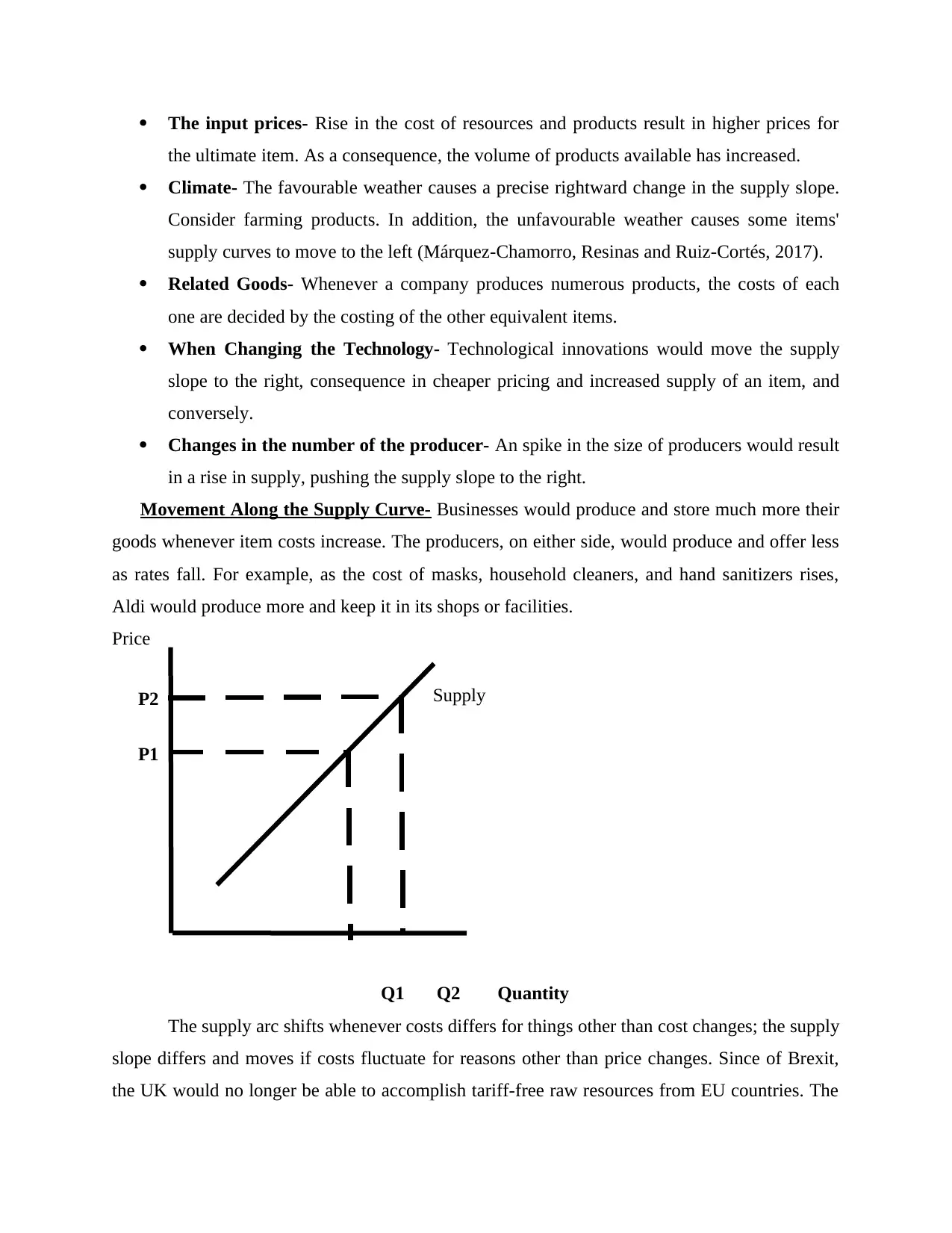
P2 Supply
P1
The input prices- Rise in the cost of resources and products result in higher prices for
the ultimate item. As a consequence, the volume of products available has increased.
Climate- The favourable weather causes a precise rightward change in the supply slope.
Consider farming products. In addition, the unfavourable weather causes some items'
supply curves to move to the left (Márquez-Chamorro, Resinas and Ruiz-Cortés, 2017).
Related Goods- Whenever a company produces numerous products, the costs of each
one are decided by the costing of the other equivalent items.
When Changing the Technology- Technological innovations would move the supply
slope to the right, consequence in cheaper pricing and increased supply of an item, and
conversely.
Changes in the number of the producer- An spike in the size of producers would result
in a rise in supply, pushing the supply slope to the right.
Movement Along the Supply Curve- Businesses would produce and store much more their
goods whenever item costs increase. The producers, on either side, would produce and offer less
as rates fall. For example, as the cost of masks, household cleaners, and hand sanitizers rises,
Aldi would produce more and keep it in its shops or facilities.
Price
Q1 Q2 Quantity
The supply arc shifts whenever costs differs for things other than cost changes; the supply
slope differs and moves if costs fluctuate for reasons other than price changes. Since of Brexit,
the UK would no longer be able to accomplish tariff-free raw resources from EU countries. The
P1
The input prices- Rise in the cost of resources and products result in higher prices for
the ultimate item. As a consequence, the volume of products available has increased.
Climate- The favourable weather causes a precise rightward change in the supply slope.
Consider farming products. In addition, the unfavourable weather causes some items'
supply curves to move to the left (Márquez-Chamorro, Resinas and Ruiz-Cortés, 2017).
Related Goods- Whenever a company produces numerous products, the costs of each
one are decided by the costing of the other equivalent items.
When Changing the Technology- Technological innovations would move the supply
slope to the right, consequence in cheaper pricing and increased supply of an item, and
conversely.
Changes in the number of the producer- An spike in the size of producers would result
in a rise in supply, pushing the supply slope to the right.
Movement Along the Supply Curve- Businesses would produce and store much more their
goods whenever item costs increase. The producers, on either side, would produce and offer less
as rates fall. For example, as the cost of masks, household cleaners, and hand sanitizers rises,
Aldi would produce more and keep it in its shops or facilities.
Price
Q1 Q2 Quantity
The supply arc shifts whenever costs differs for things other than cost changes; the supply
slope differs and moves if costs fluctuate for reasons other than price changes. Since of Brexit,
the UK would no longer be able to accomplish tariff-free raw resources from EU countries. The
Paraphrase This Document
Need a fresh take? Get an instant paraphrase of this document with our AI Paraphraser
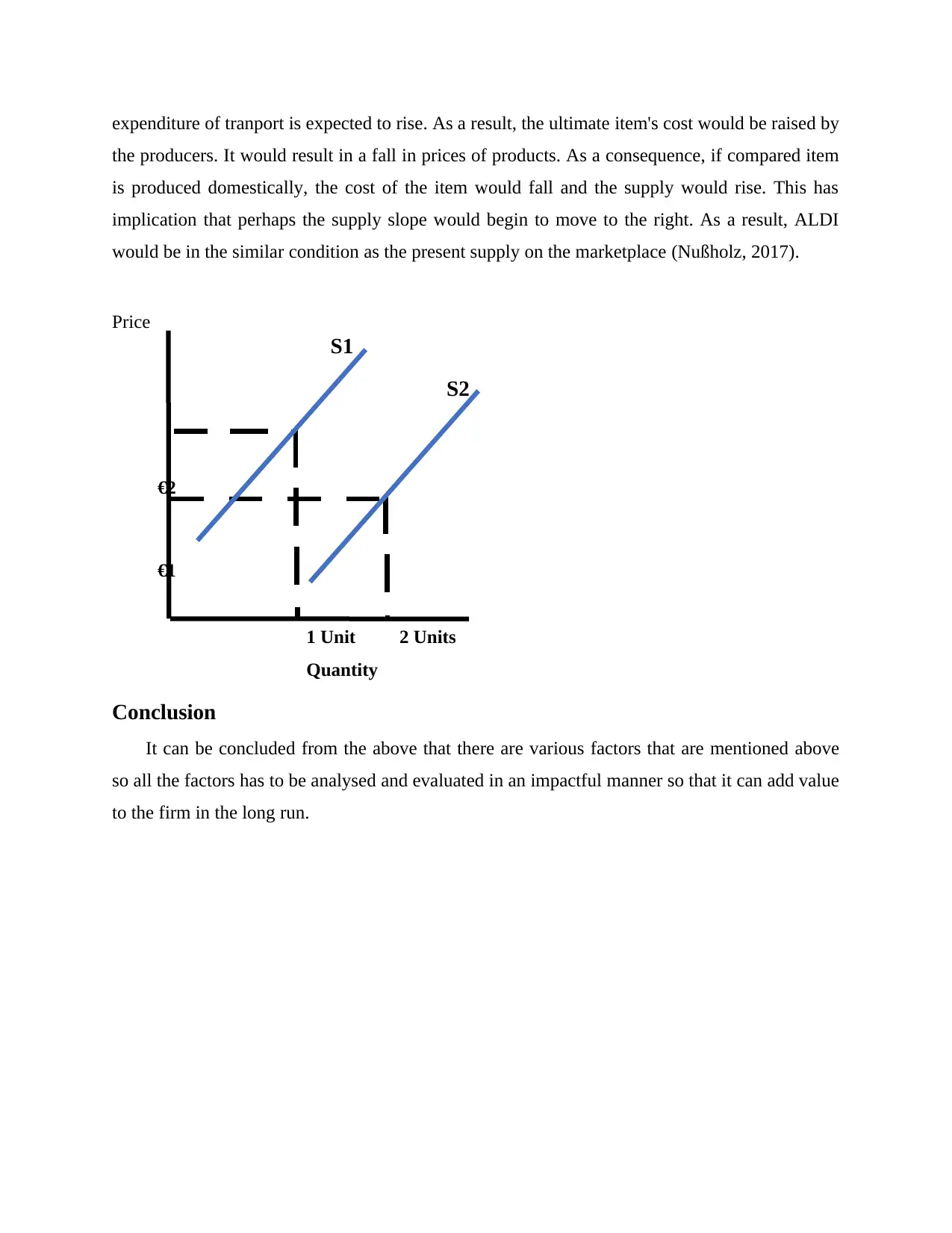
expenditure of tranport is expected to rise. As a result, the ultimate item's cost would be raised by
the producers. It would result in a fall in prices of products. As a consequence, if compared item
is produced domestically, the cost of the item would fall and the supply would rise. This has
implication that perhaps the supply slope would begin to move to the right. As a result, ALDI
would be in the similar condition as the present supply on the marketplace (Nußholz, 2017).
Price
€2
€1
1 Unit 2 Units
Quantity
Conclusion
It can be concluded from the above that there are various factors that are mentioned above
so all the factors has to be analysed and evaluated in an impactful manner so that it can add value
to the firm in the long run.
S1
S2
the producers. It would result in a fall in prices of products. As a consequence, if compared item
is produced domestically, the cost of the item would fall and the supply would rise. This has
implication that perhaps the supply slope would begin to move to the right. As a result, ALDI
would be in the similar condition as the present supply on the marketplace (Nußholz, 2017).
Price
€2
€1
1 Unit 2 Units
Quantity
Conclusion
It can be concluded from the above that there are various factors that are mentioned above
so all the factors has to be analysed and evaluated in an impactful manner so that it can add value
to the firm in the long run.
S1
S2
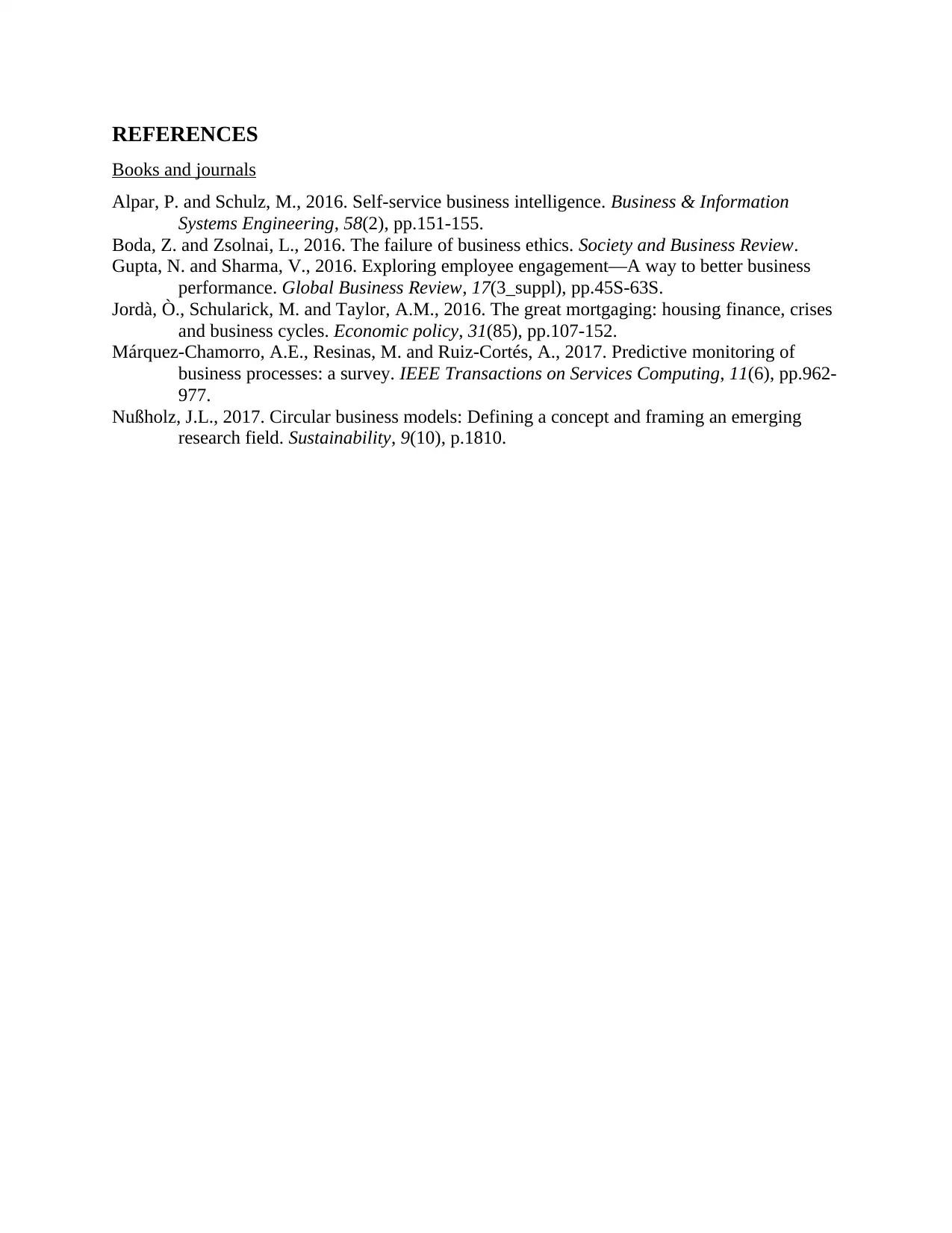
REFERENCES
Books and journals
Alpar, P. and Schulz, M., 2016. Self-service business intelligence. Business & Information
Systems Engineering, 58(2), pp.151-155.
Boda, Z. and Zsolnai, L., 2016. The failure of business ethics. Society and Business Review.
Gupta, N. and Sharma, V., 2016. Exploring employee engagement—A way to better business
performance. Global Business Review, 17(3_suppl), pp.45S-63S.
Jordà, Ò., Schularick, M. and Taylor, A.M., 2016. The great mortgaging: housing finance, crises
and business cycles. Economic policy, 31(85), pp.107-152.
Márquez-Chamorro, A.E., Resinas, M. and Ruiz-Cortés, A., 2017. Predictive monitoring of
business processes: a survey. IEEE Transactions on Services Computing, 11(6), pp.962-
977.
Nußholz, J.L., 2017. Circular business models: Defining a concept and framing an emerging
research field. Sustainability, 9(10), p.1810.
Books and journals
Alpar, P. and Schulz, M., 2016. Self-service business intelligence. Business & Information
Systems Engineering, 58(2), pp.151-155.
Boda, Z. and Zsolnai, L., 2016. The failure of business ethics. Society and Business Review.
Gupta, N. and Sharma, V., 2016. Exploring employee engagement—A way to better business
performance. Global Business Review, 17(3_suppl), pp.45S-63S.
Jordà, Ò., Schularick, M. and Taylor, A.M., 2016. The great mortgaging: housing finance, crises
and business cycles. Economic policy, 31(85), pp.107-152.
Márquez-Chamorro, A.E., Resinas, M. and Ruiz-Cortés, A., 2017. Predictive monitoring of
business processes: a survey. IEEE Transactions on Services Computing, 11(6), pp.962-
977.
Nußholz, J.L., 2017. Circular business models: Defining a concept and framing an emerging
research field. Sustainability, 9(10), p.1810.
You're viewing a preview
Unlock full access by subscribing today!
1 out of 9
Related Documents
Your All-in-One AI-Powered Toolkit for Academic Success.
+13062052269
info@desklib.com
Available 24*7 on WhatsApp / Email
![[object Object]](/_next/static/media/star-bottom.7253800d.svg)
Unlock your academic potential
© 2024 | Zucol Services PVT LTD | All rights reserved.




